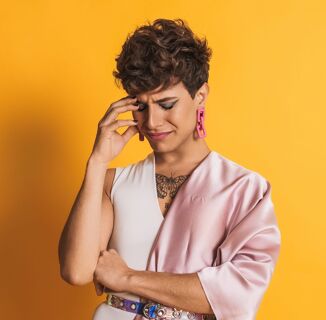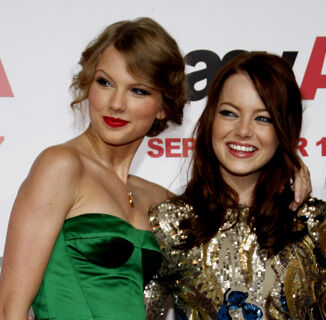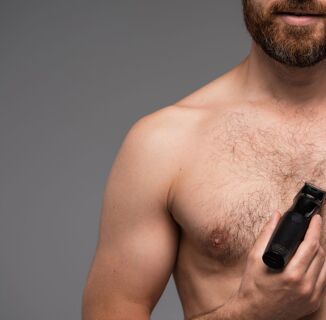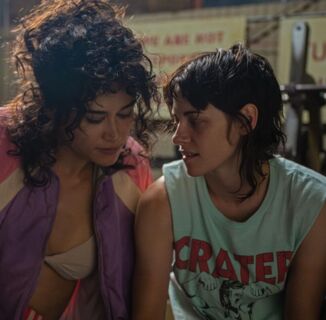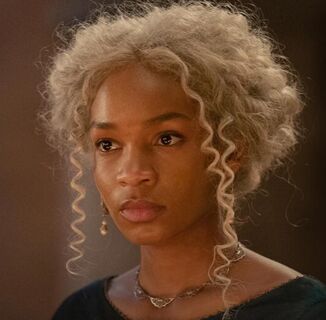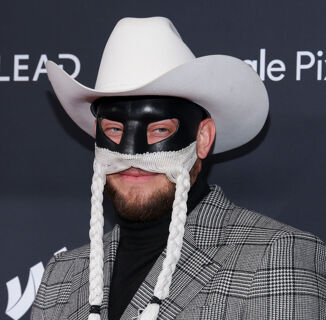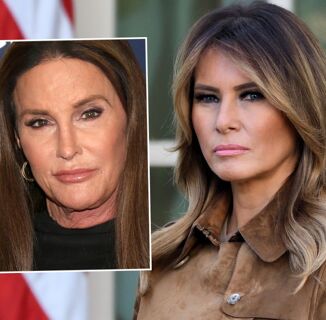I am of the mindset that every one of us searching for good queer representation goes through a phase where we’ll take whatever we can get. I’m talking the most minuscule of table scraps, the kind that have been left on your kitchen counter overnight cuz you were too tired to wipe them away before bed.
Eventually, we reach a point where we decide that we’re done with the bare minimum. No more bury your gays. No more blink and you’ll miss it. No more Voltron: Legendary Defender, a show that managed to make us stans of robotic space cats… but not of its attempt at queer representation. From everyone’s favorite space dad losing his loved one off-screen—leading to an apology from one of the showrunners—to a wedding at the tail end of eight seasons where said space dad ties the knot with… insert shrugging shoulders emoji.
I used to be OK with a few members of the studio audience being content with this messy kind of representation, but with Voltron’s finale I realized something: what if the representation had been… good? What if folks didn’t have to go through the I’ll settle for whatever phase because their options were actually well thought out? That’s what Voltron—and a lot of shows before it—could’ve been. That’s what a lot of shows could, and should, strive for in the future.
Which begs the question: what even IS good queer representation? How do we do better? Well, I’m glad I asked!
- Develop your characters
Speaking as a writer, I know that fleshed-out characters are the lifeblood of fiction. I can give you a pretty good synopsis of My Hero Academia, for example, but if you make the mistake of asking me about my favorite character? We’re gonna be talking about Izuku “Best Boy” Midoriya for a good long while.
Despite this being common knowledge amongst writers, some folks forget the importance of characterization when they decide to add queer to the mix. They stress so much about portraying “the gay” that they miss the most basic point: we don’t just want the label, we want the person; more importantly, we want the person to be part of the story as a whole instead of some box you check off on a representation list.
If you take nothing else from this piece, at least take this bit of advice: don’t stop after your character gets past the closet door! Insert hand clap emojis between each word for maximum emphasis.
- Romance is optional
Yeah. I said what I said.
Look, romance is fine, y’all, but kinda boring when you only have it there to prove that someone has a rainbow bumper sticker. If your character ain’t feeling a love or lust connection, try the following:
Visual cues: There are pieces of LGBTQ flair that can be used to signify someone’s gender or sexuality. Flags—such as the rainbow themed easter egg in PS4’s Spiderman. Headbands—like the one Titus works out with in Kimmy Schmidt. Tennis shoes that I don’t need but really, really want, like, do they have to come for our wallets during Pride Month!? It’s like an exclusive handshake between all of us, that feeling of I’m not the only one when you see someone wearing a rainbow themed lightsaber shirt, or a pronoun button at a convention.
Just say it: Let it come out naturally, of course, unless a bisexual song and dance fits the character. Speaking of Crazy Ex-Girlfriend, shows like this and Brooklyn Nine-Nine are great examples of characters who announce their orientation and even play on the bumbled attempts of friends trying to do the most when they find out. But at the end of the day, just like my first point in this piece, White Josh and Rosa wanna be treated like people, not queer caricatures.
- If you want romance, develop the love interest
Treat them as more than a “This character over here is queer” tool. We wanna care about the love interest just as much as the main character. We care about both Ruby and Sapphire in Steven Universe, not just because they make up Garnet, but because they’re loveable, adorable, individual characters. Same with Yuri and Victor from Yuri on Ice, Bubblegum and Marceline from Adventure Time, and my if they make it to the big screen please don’t yuck it up Marvel babies, Billy (Wiccan) and Teddy (Hulkling).
These romances weren’t there to prove a point, they were there because the characters had chemistry.
- Queer suffering
Listen. I love me some angst. So I’m not saying to not have your characters go through shit. I’m not even saying that you can never, ever, kill someone. Just… make sure that their only reason for being isn’t to suffer or die. If you’re familiar with Young Avengers you know that Billy Kaplan’s middle name is ANGST. He suffers. A lot. But just because he’s a queer Jewish kid doesn’t mean he’s only on the team to be an emotional punching bag because the writers don’t wanna hurt the straight folks in the story. Everyone has something they have to face so it doesn’t feel disjointed when the queer characters are hurting, too—especially since it’s part of the plot and not an I have a gay guy so he’s gotta deal with homophobic baggage B-story.
That’s not to say you can’t have queer characters who deal with homophobia. For queer creators, writing can be an outlet where we’re allowed to dissect those issues. But here’s the thing, we’re not gonna treat it as a subplot: it’s gonna be the main focus, we’re gonna flesh it out and make sure it’s not an aside. We’re also gonna make it more well-rounded because discrimination is a varied beast that ranges from blatant, derogatory language spray-painted on someone’s locker to I’m not saying two girls can’t kiss during the Thanksgiving parade but children are watching/I have queer friends/I’m fine with queerness but…
Basically, you’re doing a real disservice to the community if you make hatred so by the book, especially if it’s only there so your straight characters can feel good about themselves because hey, at least they’re nice to the poor wittle queer kid. Please remember that we are a community that thrives on chosen family. We have been saving ourselves for years, whether it’s straight up leaving a toxic situation or finding ways to escape when we can via safe spaces outside of school, work, or home. Hell, we have the Internet and hashtags we can follow.
People are more than their struggle. Focus on the triumphs and self-care as much as you focus on the pain.
- One isn’t enough
You know what’s better than one queer character? Two. Or more. Kinda like Pringles.
It’s always kinda disingenuous to me when a story only has one queer person. You mean to tell me in a city as huge and diverse as New York, Carrie Bradshaw’s only source of queerness is Stanford Blatch? That she can’t handle the concept of bisexuality? That she’s stunned when self-proclaimed try-sexual Samantha Jones dates a woman? That in the second movie Stanford marries the only other gay man we ever saw more than once on the show even if they hated each other? Carrie… you live in one of the biggest cities in the country, buy enough shoes to put you out of house and home, and you write a sex column…how are you missing all of the queer?
Beyond that, when you’re part of a community that’s prone to dealing with hate, you try and find others like you—consciously and subconsciously. Shows like The L Word where the entire group of friends are queer…are a lot more likely than you think. Even if it’s a small group of friends like my Sex and the City example, there’s still that bookstore with the All Are Welcome sign or the car you drive past with the HRC bumper sticker.
There is not only one queer thing in the world.
Extra pro-tip: by only having one queer person in your story you put a lot of extra pressure on yourself. That lone character becomes the representative the audience latches onto, so whatever happens to them they will be judged harder than Scarlett Johansson taking any role for the next 50 years.
Give the audience—and yourself—options.
- Don’t be afraid of the word “and”
As a black, queer woman… please?
Intersectionality is more than a word that gets tossed around every once in a while, and if you don’t realize the impact of it, then I’m gonna politely ask that you check out Anissa Pierce and Grace Choi from Black Lightning. Your queer character is allowed to have multiple layers to them. Diversity doesn’t just stop at sexuality. Oh, and that and? Can involve multiple facets of the queer community itself. Transgender and? Yes, please.
- Let your characters out themselves
There is nothing more frustrating than having a creator come out of the woodwork to give an oh by the way statement. It sounds great on paper until you start to wonder… why didn’t we get that in the story itself? This also applies to creators making grand declarations before their work is released. I know you wanna prove that you have us in your thoughts and prayers, but that quote you just made in that interview creates monumental expectations. Clearly, you spent a lot of time on this character, otherwise, why even bring them up? So if the representation is nothing but a passing glance the audience feels cheated, at best.
If you have to tell us someone is queer instead of letting the story illustrate it, then you’ve done the character, and the community, a great disservice. Let the story do the talking.
The key to good representation isn’t anything new, or even groundbreaking. It just requires as much love and care as every other element in your story.
Help make sure LGBTQ+ stories are being told...
We can't rely on mainstream media to tell our stories. That's why we don't lock our articles behind a paywall. Will you support our mission with a contribution today?
Cancel anytime · Proudly LGBTQ+ owned and operated
Read More in Culture
The Latest on INTO
Subscribe to get a twice-weekly dose of queer news, updates, and insights from the INTO team.
in Your Inbox

